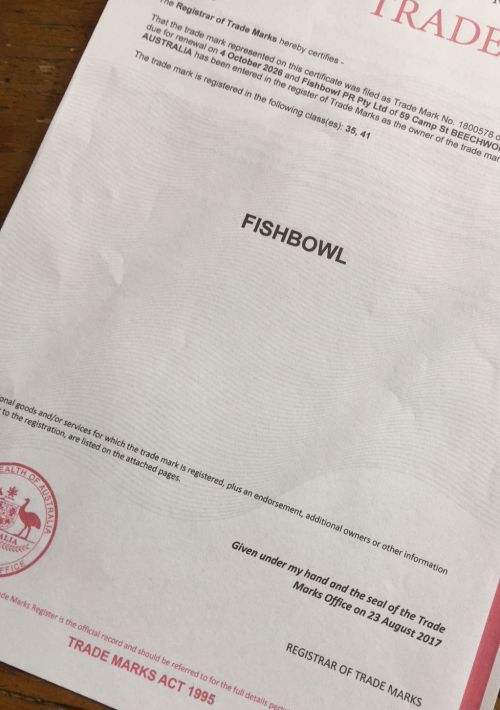How disruptive would it be if you had to change your business name?
Think of what’s involved: new branding; domain name changes; new signage; marketing materials and bank accounts; dealing with the tax office and suppliers and advising all your clients and prospective clients of your new name.
If you run a business I expect you wouldn’t find the prospect of doing all this very appealing, especially when you’d rather be providing products or services to help your clients.
Last year I spent 11 months working through the process of protecting my business name rather than having to change it. While I am not a trade mark attorney, I would like to share what I learned in the hope that other business operators will consider how secure their ‘mark’ is in this globally connected world.
You may have your business name registered with ASIC but that doesn’t secure the trade mark or your right to use it.

I have operated Fishbowl PR for eight years. In 2016 I was contacted by an Intellectual Property (IP) lawyer who advised me that an international company had applied to use the mark Fishbowl in Australia. Two parts of the competitor’s business fell within the same ‘classes’ as mine – public relations and training. The options for me were to either defend my right to the mark given my pre-existing use, or walk away and re-name my business, because once they secured the right to the mark, I could be in breach if I continued to use it.
I started working with the IP lawyer to lodge an application to register a trade mark in September 2016. At this stage I hear you thinking, that’s no more fun than all the work involved in changing your name. And you are right – these were exactly my thoughts! But on balance, I felt the cost would be similar and this approach, if successful, would have less impact on the established reputation of my business.
And so began the challenging process:
- At the start of October we lodged the initial application. The Trade Marks Office had three months to examine it while examining the competitor’s application at the same time.
- In March they questioned the ‘distinctiveness’ of the mark. I had to produce detailed evidence including: the history of the business; financials; online and traditional promotions; copies of letterheads, business cards and other printed materials; evidence of workshops I had run and my membership of professional organisations.
- But before we had lodged this information, the Trade Marks Office advised us they had accepted the competitor’s application to register the trade mark. I then had to consider if I wanted to oppose that registration or accept that we could co-exist because I served a small geographical area that they were unlikely to operate in regularly, if at all. I faced more decisions and, if I chose to oppose, more cost.
- We filed our ‘evidence’ with the Trade Mark Office in May.
- In early June we were advised that our application had been accepted with amendments to the details of the ‘class’ and we were happy with these amendments. However, we had one day to oppose the competitor’s application to use the mark. Given the cost, I decided against it.
- The IP lawyer then lodged submissions with the Trade Marks Office based on our acceptance. Any opposing organisation then had two months to oppose. If anyone did, that would mean another decision about defending that case … and more lawyers’ fees.
- In August we learnt there had been no opposition to our application but we still had to wait for formal notification before we could use the ®
While I had expert and considered advice from my IP lawyer, taking on a large international company with greater financial resources and waiting long periods between each step was nerve wracking. Realising that at each step there could be varied outcomes that required more legal advice and costs, also made me question my decision to proceed in the first place.
If this short summary can save another small business this headache, then it has been worth writing. I suggest you register your trade mark as a matter of course rather than act when another business shows interest in it.
This experience highlights that the world is now so much more globally connected and that, while the competitor may never operate their PR and training services in Australia, as an international company it is good practice for them to register relevant trade marks as widely as possible.
Other international companies may be doing the same with your business name in your ‘classes’ as we speak.
